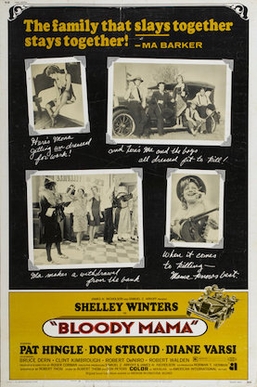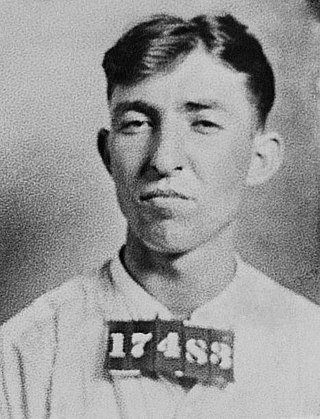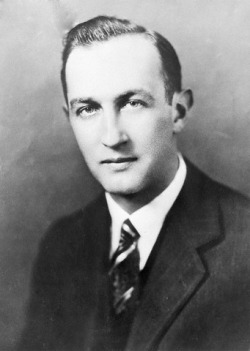
The Saint Valentine's Day Massacre was the murder of seven members and associates of Chicago's North Side Gang on Saint Valentine's Day 1929. The men were gathered at a Lincoln Park, Chicago garage on the morning of February 14, 1929. They were lined up against a wall and shot by four unknown assailants, two of whom were disguised as police officers.

Kate Barker, better known as Ma Barker, was the mother of several American criminals who ran the Barker–Karpis Gang during the "public enemy era" when the exploits of gangs of criminals in the Midwestern United States gripped the American people and press. She traveled with her sons during their criminal careers.

Alvin Francis Karpis, was a Canadian–American criminal of Lithuanian descent known for being a leader of the Barker–Karpis gang in the 1930s. Nicknamed "Creepy" for his sinister smile and called "Ray" by his gang members, Karpis led the gang along with Fred Barker and Arthur "Doc" Barker. There were only four "public enemies" ever given the title of "Public Enemy #1" by the FBI and he was the only one to be taken alive. The other three, John Dillinger, Pretty Boy Floyd, and Baby Face Nelson, were all killed before being captured. He also spent the longest time as a federal prisoner at Alcatraz Federal Penitentiary, serving twenty-six years.

A shootout, also called a firefight, gunfight, or gun battle, is a armed confrontation entailing firearms between armed parties using guns, always entailing intense disagreement(s) between the fighting parties. The term can be used to describe any such fight, though it is typically used in a non-military context or to describe combat situations primarily using firearms.

Bloody Mama is a 1970 American exploitation crime film directed by Roger Corman, and starring Shelley Winters in the title role, with Bruce Dern, Don Stroud, Robert Walden, Alex Nicol and Robert De Niro in supporting roles. It was very loosely based on the real story of Ma Barker, who is depicted as a corrupt, mentally-disturbed mother who encourages and organizes the criminality of her four adult sons in Depression-era southern United States.

Guns Don't Argue is a 1957 low-budget feature film about the early achievements of the FBI in defeating the most notorious criminals of the 1930s. The film involves dramatizations of the crimes and eventual demise of various gangsters, along with a moralistic narrative. It was edited together from a composite of three episodes from the 1952 TV series Gangbusters.
Edna "Rabbit" Murray (1898–1966) was an American criminal associated with several high-profile gangs in the Depression-era of the early 1930s. Although popularly known to the press as the "Kissing Bandit" for kissing a male robbery victim, she was known in the underworld as "Rabbit" for her skills in breaking out of the penitentiary.
Fred Samuel Goetz, also known as "Shotgun" George Ziegler, was a Chicago Outfit mobster and a suspected participant in the Saint Valentine's Day Massacre, in 1929.

Public Enemies is a 1996 film directed by Mark L. Lester. The movie, which centers on the 1930s figure Ma Barker and her criminal sons, was filmed in Guthrie, Oklahoma. The film was released on direct-to-video in the United States in November 1996.

Arthur Raymond "Doc" Barker was an American criminal, the son of Ma Barker and a member of the Barker-Karpis gang, founded by his brother Fred Barker and Alvin Karpis. Barker was typically called on for violent action, while Fred and Karpis planned the gang's crimes. He was arrested and convicted of kidnapping in 1935. Sent to Alcatraz Federal Penitentiary in 1936, he was killed three years later while attempting to escape.

Ma Barker's Killer Brood is a 1960 American neo noir crime film, released in 1960. The low-budget film was directed by Bill Karn and starred Lurene Tuttle as the title character, Ma Barker.

John Paul Chase was an American bank robber and Depression-era outlaw. He was a longtime criminal associate of the Karpis-Barker Gang and most notably Baby Face Nelson who later brought him into the John Dillinger gang. FBI Director J. Edgar Hoover once referred to Chase as "a rat with a patriotic-sounding name". Chase and Nelson continued to rob banks with John Dillinger until Dillinger's death in July 1934. After the death of Nelson in November 1934, Chase fled back to California where he was arrested a month later on December 27, 1934. Chase was sent to Alcatraz where he became one of the longest-serving inmates;.
Lawrence DeVol was an American criminal, bank robber, prison escapee and Depression-era outlaw. He was connected to several Midwestern gangs during the 1920s and 1930s, most often with the Barker-Alvin Karpis and Holden-Keating Gangs, and was also a former partner of Harvey Bailey early in his criminal career. DeVol is known to have killed at least eleven people during his criminal career, including six law enforcement officers.
Russell "Slim Gray" Gibson was an American bank robber and Depression-era outlaw associated with Alvin Karpis and the Barker Gang during the late 1920s and 1930s. Gibson spent much of his early criminal career with the Central Park Gang based in Tulsa, Oklahoma which included the Barkers, Volney Davis, Ray Terrill and other local criminal figures. He participated in his first major robbery when he teamed with Neal Merritt and James "Cowboy" Long to rob a bank messenger in Oklahoma City of $75,000. Gibson was arrested for this robbery, but escaped from county jail prior to his trial.

Harold Eugene "Eddie" Green was an American bank robber and Depression-era outlaw during the 1930s, best known as a member of the John Dillinger gang. He was also associated with Frank "Jelly" Nash, Volney Davis and the Barker-Karpis Gang in his early career.

Herbert Allen Farmer, was an American criminal who, with his wife Esther, operated a safe house for underworld fugitives from the mid-1920s to 1933.

Frederick George Barker was an American criminal who, along with Alvin Karpis, co-founded the Barker-Karpis gang, which committed numerous robberies, murders and kidnappings during the 1930s. Barker was the youngest son of Ma Barker, all of whose children were criminals. He was killed in a lengthy gunfight with the Federal Bureau of Investigation (FBI) in 1935.

The kidnapping of Edward Bremer was the last major criminal enterprise of the Barker-Karpis gang. Though successful in netting the gang a large ransom, it brought down the full force of the FBI on the gang, resulting in the death or capture of its main members in the months afterwards. The kidnapping was ordered by St. Paul Jewish-American organized crime boss Harry Sawyer, and carried out by Fred Barker, Alvin Karpis, Arthur Barker, Volney Davis and Chicago Outfit mobster George Ziegler.

Queen of the Mob is a 1940 American film, directed by James P. Hogan.

The Barker–Karpis Gang was one of the longest-lived criminal gangs during the Depression Era, spanning from 1931 to 1935. The gang was founded by Fred Barker and Alvin Karpis, and later joined by Fred's brother Arthur "Doc" Barker. Along with the three core members, the gang's network spanned up to 25 members at one point.



















